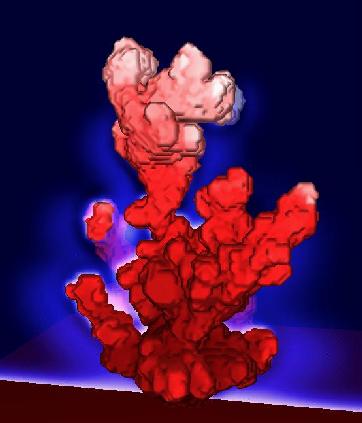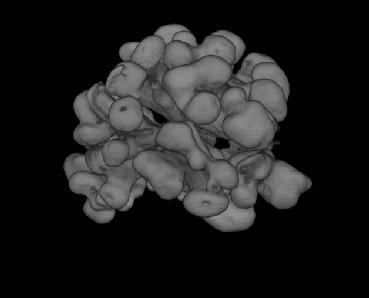
Simulated growth form and external nutrient gradients

Volume rendered image of a CT scan of the scleractinian coral in Madracis
This project is a collaboration between the section Computational Science of the Universiteit van Amsterdam (UvA), coral and sponge biologists, biologists working on biomechanics and researchers from molecular developmental biology (see below: ``The research team'').
A fundamental question in biology is how the interplay between the genome and the physical environment drives pattern formation and morphogenesis. With the availability of new computational techniques (particle-based techniques as for example lattice gases and the lattice Boltzmann method) in combination with large scale computing facilities, in silico experiments are becoming more and more an important option to study this question and investigate self-organisation and emergent behaviour in biological systems. Furthermore an enormous amount of progress has been made this last decade within the developmental biology. Also, the genomes of some important experimental organisms have now been or are now being elucidated. Potentially this combination of new discoveries in developmental biological and new computational techniques may advance this field enormously. Work on morphogenesis and pattern formation, using modelling and simulation in addition to in vitro an in vivo experiments, has many implications for research in medicine and biology. Examples are studies on carcinogenesis, studies on regeneration capabilities and ecological studies on growth and form and the impact of the physical environment.
Within the metazoans, sponges and cnidarians represent the phyla with the simplest body plan and a relatively simple regulatory network controlling the development. This makes these organisms an excellent case study for understanding morphogenesis and the physical translation of the genetic information into a growth form, using a combination of a biomechanical models of growth and form and a model of the spatial and temporal expression of developmental genes. Understanding external deciding factors in growth and morphology of reef corals and sponges is essential to elucidate the role of these organisms in marine ecosystems, and to explain their susceptibility to pollution and global climate change. An important issue in growth and form of sponges and corals is the the thickness of boundary layers and mass transfer of metabolites and nutrients from the external environment to the organism through the boundary layer, it is hypothesized that this mass transfer is strongly influenced by the physical environment.
We are investigating the morphogenesis in sponges and corals by combining simulation studies with experimental studies, we are using the following approaches:
1. We are developing simulation models of regulatory networks, These models will be based on temporal and spatial gene expression pattern during development in sponges and scleractinian corals
2. Development of biomechanical models of growth and form (accretive growth models, models of cell aggregates) and the impact of the physical environment. The simulated morphologies are compared in a morphological analysis to three-dimensional images of the actual organisms, obtained with CT-scanning techniques.
3. Development of advection-diffusion models to study the boundary layer formation in three-dimensional images of the actual organisms. The simulation results are compared with data stemming from flume tank experiments, NMR experiments and Acoustic Doppler velocitymetry